In “Henry VI,” Performance Art Transforms a Shakespearean Classic
“Henry VI,” an adaptation of Shakespeare’s trilogy of the same name, directed by New School for Drama professor Casey Biggs, debuted on October 13 to a full auditorium at The New School for Drama Theater at 151 Bank St.  The play is the first production at the Drama School since Pippin Parker became director in July.
The play is the first production at the Drama School since Pippin Parker became director in July.
Parker joined the Drama School in 2004 and became playwriting chair in 2006. He has recruited high-profile instructors like Jon Robin Baitz to the school and created the division’s Artist-in-Residence program. He is also a co-founder and former artistic director of Naked Angels, a theater company noted for producing plays on controversial social topics, and helped found the company’s Issues Projects, which collaborates with organizations like Amnesty International and Project ALS, which works to find and fund a cure for brain diseases.
Parker has also been part of the division’s ongoing transition. In 2005, the division’s contract with the Actors Studio ended, prompting a name change from the Actors Studio Drama School to The New School for Drama. Since the change, there has been a shift to more voice and movement training in the acting department.
“Henry VI,” believed to be written in 1591, is set during King Henry VI of England’s reign. It opens with the events leading up to the War of Roses (1455-85) in part one. The second and third parts focus on the rise of the Duke of York and the horrors caused by the conflict.
The focus on voice and movement training is evident in this production of “Henry VI”. The production, which was adapted by student and actor Noelle Stewart, is a combination of all three of Shakespeare’s “Henry VI” plays.
The set resembled more of an art installation than medieval England. The stage and walls were bright white, with large cubes stationed around the stage for the actors to move and use. A black wooden chair sat atop two stairs, a spatter of red paint resembling blood above it. Two sound designers, called Prism House, sat on the corner of the stage and created rhythms for background noise and music.
The actors were all barefoot and painted white, some wearing white clothes. Prominent characters like Henry VI, Queen Margaret and the dukes wore more eye-catching costumes. The Duke of Winchester donned a long red gown with gold details, similar to a kimono, and a frilly white collar around his neck.
The actors didn’t need an elaborate set or fancy costumes to make the audience feel like they were in England, turmoil surrounding them. When Cade, the character enlisted by the Duke of York to incite a rebellion, was yelling at a crowd or Queen Margaret was sitting on the stage, crying, the dialogue was natural.
There was some gender bending — Henry VI was played by a woman — but it didn’t distract from the plot. When Queen Margaret kissed Henry, the focus was on Henry’s ecstatic grin, not the fact that two girls just kissed on the stage.
During a fight scene, an actor looked out into the small theatre and screamed, “Bleed!” at an audience member. The effect was unnerving, as if the actor were attacking the audience, not his opponent. This break from tradition further added to the power of theperformances, rather than detracting from this classic production.







Leave a Reply